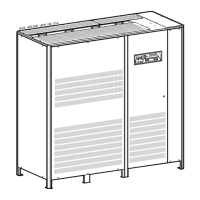
Do you have a question about the GE Digital Energy SG 400 kVA and is the answer not in the manual?
| Apparent Power | 400 kVA |
|---|---|
| Frequency | 60 Hz |
| Battery Type | Valve Regulated Lead Acid (VRLA) |
| Operating Temperature | 0 to 40 °C |
| Topology | Double Conversion |
| Communication Interface | RS-232 |
| Dimensions | Varies by configuration |
| Weight | Varies by configuration |
| Input Voltage | 480V |
| Output Voltage | 480V |
Provides an introduction and overview of the manual's content and purpose.
Critical information to prevent injury and equipment damage during operation.
Highlights the primary advantages and technological aspects of the SG Series UPS.
Illustrates the main components of the UPS system and their interconnections.
Describes the microprocessor-based control system managing UPS operations.
Explains the roles of the rectifier and inverter in power conversion.
Describes both Automatic and Manual Bypass functionalities for load transfer.
Outlines the function of the battery in supplying DC power to the inverter.
Describes the standard functioning of the UPS when utility power is stable.
Explains how the UPS operates when the utility power supply fails.
Outlines the UPS behavior when utility power is restored after a failure.
Details automatic bypass transfer and manual bypass operation procedures.
Explains the concepts of paralleling UPS units for capacity and redundancy.
Details the advantages and characteristics of the Redundant Parallel Architecture.
Covers how parallel units are controlled and synchronized with each other and the utility.
Explains how the load is distributed equally among parallel UPS units.
Shows the exterior appearance of the SG Series UPS unit.
Identifies and describes the function of the manual switches on the UPS.
Details the user interface and controls found on the UPS front panel.
Describes the connectivity rack, including the customer interface board and SNMP card.
Presents a visual overview of the UPS control panel layout and elements.
Details the specific actions and meanings associated with each control panel button and LED.
Describes the status indicated by various LEDs on the UPS control panel.
Details the LCD screen's capabilities, including metering and event history.
Describes the physical screen and its input keys.
Details the three primary menus: Metering, Alarms, and Parameters.
Describes the primary screen showing overall UPS status, load, and battery backup.
Details information regarding battery voltage, current, and charge level.
Shows how to view data related to the bypass utility source.
Displays metering information for the rectifier and bypass utility input.
Shows inverter status, output voltage, frequency, and load information.
Provides detailed load information per phase, including power and apparent power.
Displays system temperature, operating times, and other miscellaneous information.
Shows counts of different types of utility faults and overloads.
Provides details such as UPS model, software version, and serial number.
Describes how to enter and navigate the alarms mode on the LCD screen.
Provides a comprehensive list of UPS alarms with their codes and meanings.
Lists UPS messages, their codes, and explanations of operational states.
Provides a form for documenting UPS status and events for troubleshooting.
Details the process of entering the parameter configuration mode.
Explains how to modify individual UPS parameters using the edit mode.
Differentiates parameter types (numeric, range, boolean) and editing procedures.
Instructions for setting the UPS's internal date and time.
Guides users on configuring modem and alarm signaling parameters.
Details how to set up telephone numbers for modem dial-out.
Covers customization of the UPS LCD display, including name, contrast, and language.
Explains how to configure and use a serial printer with the UPS.
Covers the operational procedures for a standalone SG Series UPS unit.
Explains how to operate the SG Series UPS as a frequency converter.
Covers the procedures for operating multiple UPS units in a parallel configuration.
Procedures for parallel UPS systems that share a common battery bank.
Step-by-step guide to safely start up a single SG Series UPS unit.
Steps to safely shut down the UPS for maintenance while keeping the load supplied.
Procedures to transition from manual bypass mode back to normal VFI operation.
Detailed steps for a complete shutdown of the UPS when no load is supplied.
Steps to restart the UPS and restore normal operation after a total shutdown.
Procedure to restore normal operation after an Emergency Power Off (EPO) event.
Step-by-step guide to start the UPS when configured as a frequency converter.
Procedure for a complete shutdown of the UPS when operating as a frequency converter.
Steps to restore normal operation after a total shutdown in frequency converter mode.
Procedure to restore normal operation after EPO in frequency converter mode.
Step-by-step guide to start up multiple UPS units in a parallel system.
Steps to perform a maintenance shutdown on a parallel UPS system.
Procedure to switch a parallel system from manual bypass back to VFI mode.
Steps to safely remove a single UPS unit from a redundant parallel configuration.
Steps to safely add a previously separated UPS unit back into a parallel system.
Procedure to shut down a parallel UPS system when no load is connected.
Steps to restore a parallel system after a total shutdown event.
Procedure to restore a parallel system after an EPO event.
Step-by-step guide to start up parallel UPS units with a shared battery.
Steps for performing a maintenance shutdown on a parallel system with a common battery.
Procedure to switch a common battery parallel system from manual bypass to VFI mode.
Steps to remove a unit from a parallel system sharing a common battery.
Steps to add a unit back into a parallel system with a common battery.
Procedure to shut down a parallel system with a common battery without load.
Steps to restore operation after a total shutdown in a common battery parallel system.
Procedure to restore operation after EPO in a common battery parallel system.
Describes communication cards and software for remote monitoring and management.
Lists optional hardware kits and filters that can be installed inside the UPS cabinet.
Details the installation and connection of the Remote Signalling Box.
General recommendations for maintaining UPS reliability through periodic checks.
Explains the 'service check' indicator and when to contact service.
Guidelines for cleaning and maintaining the UPS's cooling system.
Information on replacing components with a defined service life.
Recommendations for battery maintenance, including periodic testing.
Advice on managing the UPS during extended periods of inactivity.
Specifies ideal conditions for the UPS and battery room environment.
Lists specific periodic maintenance tasks to be performed on the UPS modules.

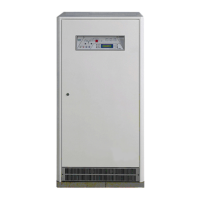





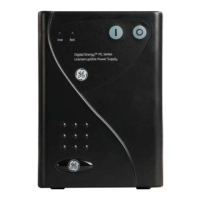
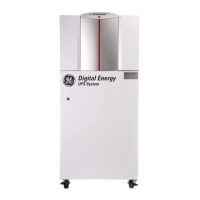
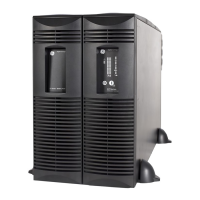
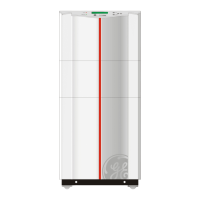
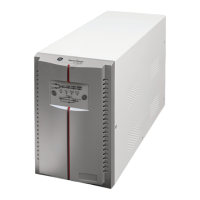
